The outside of the gaming centre, on a new industrial estate, so it is wise to have the phone number of the centre in case your satnav cannot get you to right place. Plenty of car parking.
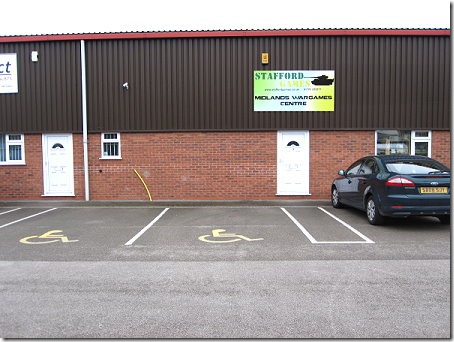
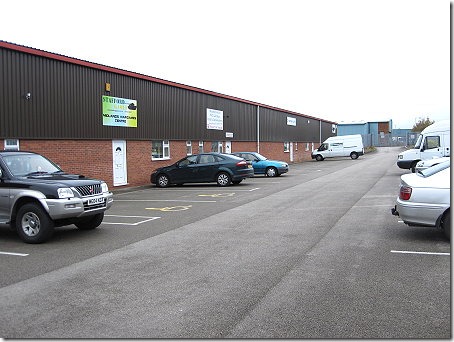
Inside, a wide range of gaming products, rules, magazines, paints, tools, scenery…..
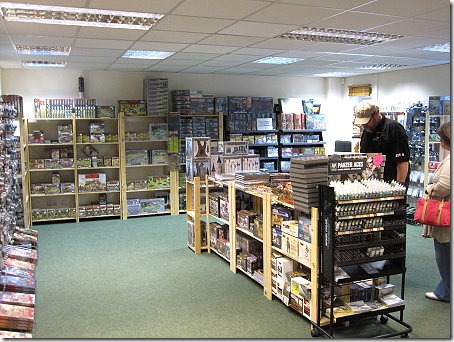
The gaming area with 17 six foot by four foot tables
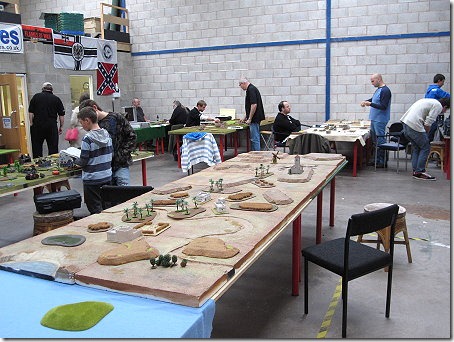
Then some photos of the games of Clash of Empires we were trying out. In this series of photos I followed a battle between Romans and a Macedonian Successor army.
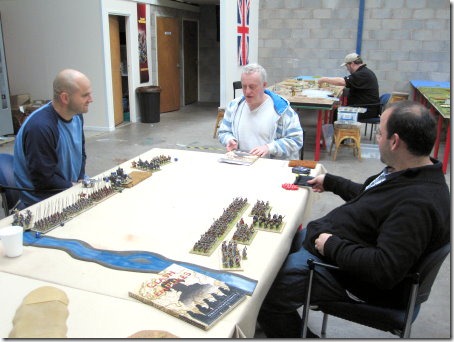
The Successor force, mainly pikes but with some good cavalry and elephants
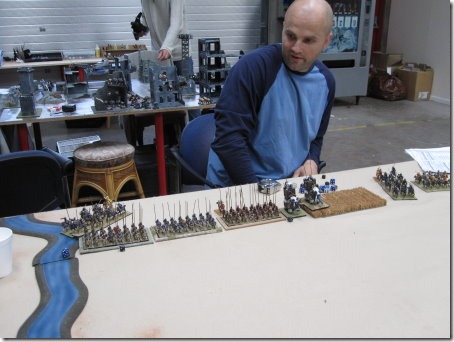
The Romans, bunched up to take advantage of their superior fighting skills. The idea being to deny the Successor advantage in numbers.

Now these are some more detailed photos, click on the links underneath the photos if you want to see the full sized pictures.
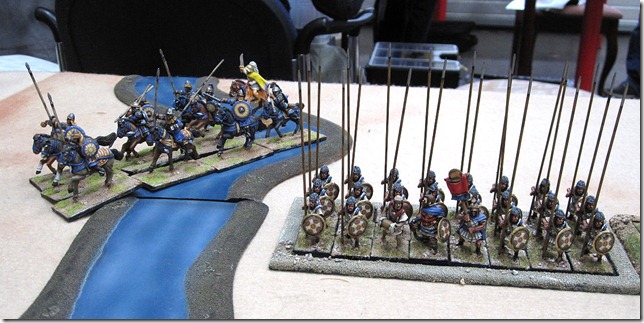
http://www.3vwargames.com/events/staffordgames2011/mids100811_14.jpg

http://www.3vwargames.com/events/staffordgames2011/mids100811_15.jpg
Now the action of the game. On the Roman right, some Successor Persian cavalry came round and charged a unit of Gallic cavalry, hoping to expose the Roman rear to attack.
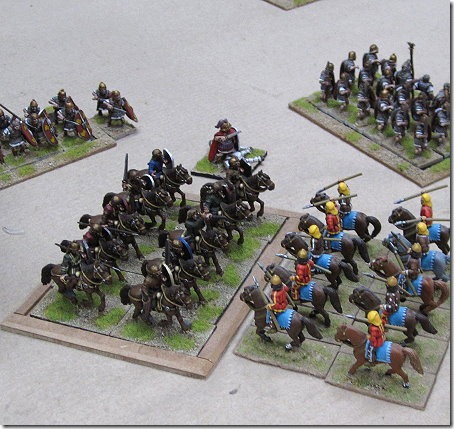
The Gallic cavalry counter-charged, so that they would have the bonuses for charging as well. The combat did not go well for the Persians as they failed to score a single hit on the Gallic cavalry. But the Gallic cavalry scored two kills on the Persians.
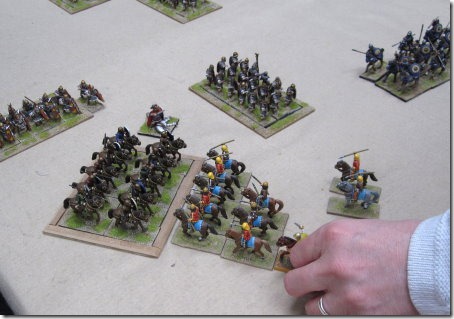
The Gallic cavalry combat result was boosted by the presence of the Roman commander and combined with a poor (high) die roll for the effects of combat, the Persian cavalry unit was destroyed and simply removed. The Gallic cavalry then had to pursue (as warband they must do this) and in turn were charged and wiped out by the Successor cavalry in the top right of the above picture. Note: in Clash of Empires wedge formation is represented by a column 3 wide, in which the first 3 ranks fight.
You can see that to be safe the Roman player formed a unit of legionaries round behind the Gallic cavalry, just in case the Gauls lost. When the Gallic cavalry were wiped out, this unit was then protecting his flank. Romans are disciplined troops and able to manoeuvre extremely well under Clash of Empire.
But now the main lines of the armies are ready to clash. The Successors have yet another unit of cavalry going round the Roman flank on the far side of the picture but the river has really hindered its movement.

The Successor commander decided that given all the advantages of the Roman legionaries, it would be safer to charge that end Roman unit with two elephants and see what happened – this is a learning experience after all.
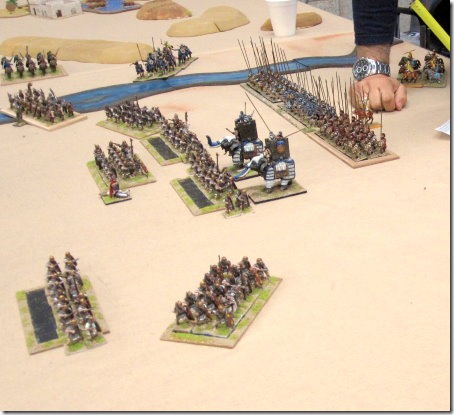
The Roman unit is hit (it failed to do any damage with their pila as the elephants charge in), take 4 casualties and do none in return. The combat result is flee for the Romans and they are caught and run down by one of the pursuing elephants (the elephant rolled a higher pursuit move than the Roman flee move). That Roman unit is simply removed and as a result of a failed morale test the rearmost Roman legionary unit also flees.
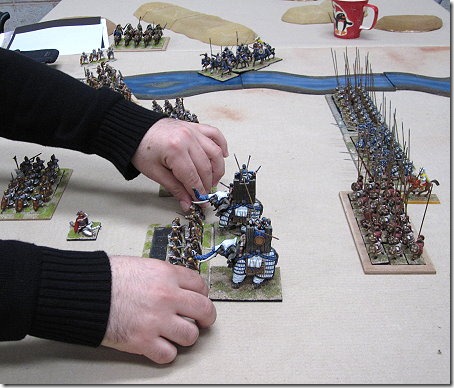
So this is the situation at the point I left to travel back home
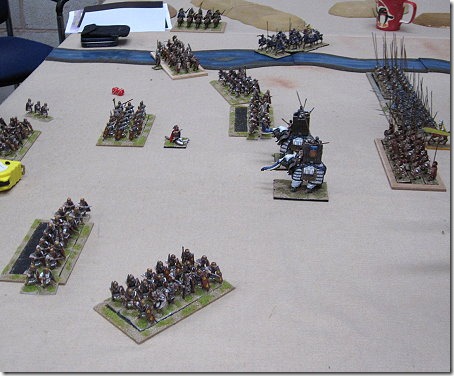
The Romans have lost one unit of legionaries, another fleeing, one unit of cavalry (the only one they had) compared to the Successor loss of a cavalry unit. There is a fairly big hole in the Roman line and 2 elephants ready to charge anything that enters it. The next move is a Roman one but it does look as if they are going down to defeat.




![wf_greek_hoplite_heads[1] wf_greek_hoplite_heads[1]](http://lh6.ggpht.com/-G1o31MVuEvY/Tov9Qi6YRMI/AAAAAAAAASQ/zzMekYbuH7M/wf_greek_hoplite_heads%25255B1%25255D%25255B2%25255D.jpg?imgmax=800)
![wf_greek_hoplite_bodies[1] wf_greek_hoplite_bodies[1]](http://lh6.ggpht.com/-Avi5mmq6LO0/Tov9RF1qvXI/AAAAAAAAASU/Rz_aC5cmQNY/wf_greek_hoplite_bodies%25255B1%25255D%25255B2%25255D.jpg?imgmax=800)
![wf_greek_hoplite_arms[1] wf_greek_hoplite_arms[1]](http://lh5.ggpht.com/-l2C6TAbfou4/Tov9R2LG4dI/AAAAAAAAASY/ok7wMlXmQiU/wf_greek_hoplite_arms%25255B1%25255D%25255B2%25255D.jpg?imgmax=800)
![wf_greek_hoplite_weapons[1] wf_greek_hoplite_weapons[1]](http://lh5.ggpht.com/-6kjMy-7fh6o/Tov9SaNwKcI/AAAAAAAAASc/c2xgHKA9VmA/wf_greek_hoplite_weapons%25255B1%25255D%25255B2%25255D.jpg?imgmax=800)
![wf_greek_hoplite_shields[1] wf_greek_hoplite_shields[1]](http://lh4.ggpht.com/-3n4JCGtfECY/Tov9S1MV4YI/AAAAAAAAASg/lt44IHwkfME/wf_greek_hoplite_shields%25255B1%25255D%25255B2%25255D.jpg?imgmax=800)
![wf_greek_hoplite_bases[1] wf_greek_hoplite_bases[1]](http://lh4.ggpht.com/-0WiTY9X-skk/Tov9TpPCJHI/AAAAAAAAASk/5ef_eieeap8/wf_greek_hoplite_bases%25255B1%25255D%25255B2%25255D.jpg?imgmax=800)